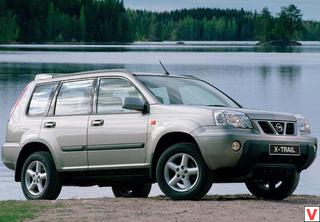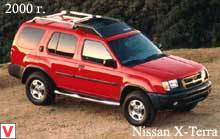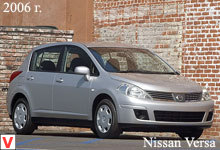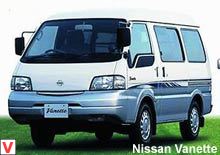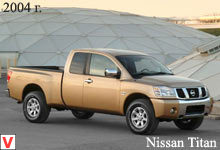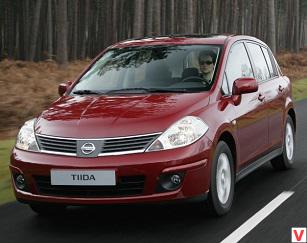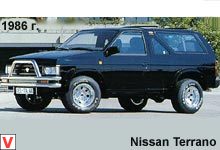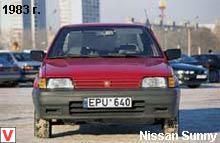
The original Nissan Tino debuted in the fall of 1998. The prototype of the European modification was presented at the Geneva Motor Show in the spring of 1999, and a year later the Tino production began at the Nissan plant in Barcelona (Spain). Work on the project took three years and was carried out mainly by European experts at the Nissan Technical Center in the UK. At the heart of the car is a platform type MS (medium-small) from the model Nissan Sunny.
The body turned out short, high and wide. With overall dimensions of 4270x1760x1610 mm, the Tino has become one of the most compact in its class. Exterior design draws attention to the elegant sleek shape, high vertical tail lights and expressive head optics. As befits a compact, but still van, Tino has large doorways, a flat floor and a high spacious interior with a lot of transformation options. Despite its relatively short length, the useful volume of the inner space in Tino is one of the most solid in the class. The distribution of seats in cars of the first years of release was extremely original: three people in the front and three in the back, for a total of 6 seats.

But buyers are not too vividly supported this "uniqueness", so after a small modernization, which took place in 2000, a modification appeared in the model range with the usual distribution of seats and their more usual number (5). In the 5-seater saloon there are 24 different seat arrangements, due to the three separate rear seats that can be separated and put together, rearranged or dismantled altogether. Below them are two box-hiding places, a couple more voluminous boxes under the front seats and, of course, many small shelves, pockets, "glove compartments" in front of the panel and on the doors, and on the backs of the front seats - folding tables.
The side seats of the rear row can move in the longitudinal direction, they can independently deviate 6 degrees backward and 9 degrees forward, increasing the luggage space. When accommodating 5 passengers the volume of the luggage compartment is 440 liters, if you remove the rear row of seats the amount of usable space for luggage increases to 1030 liters. Vertical fit and large glass area provide a good overview. The unusual architecture of the front panel, which is made sloping - starting from near the windshield, glides down smoothly. The panel as it flows to the central part, topped with a functional unit that combines the navigator, audio system and instrument panel.
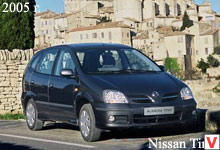
The latter is conveniently arranged in gray tones: dark gray dials with white numerals are placed on a light gray field. Tino is offered in several versions according to the trim level: Comfort, Ambience and Luxuri. Tino is equipped with engines with direct injection of gasoline into the combustion chamber of 1.8 l / 120 hp. or 2.0 l / 135 hp The maximum speeds are respectively 155 and 165 km / h. With the most powerful gasoline engine, only a continuously variable CVT variator is mounted, and with the others a five-speed manual gearbox. For some markets, a 1.6-liter gasoline unit is also provided. Nissan Tino is equipped with disc brakes on all wheels and ABS.
Suspension: front - independent type "McPherson" with anti-roll bar, assembled on a subframe; Rear - dependent, with two trailing arms and the mechanism of Scott-Russell. The suspension is tough, but it provides, despite the great height of the body, minimal heels, lack of buildup, as well as fairly clear and quick reactions on the road. Safety is key to making the Nissan Tino. The company adheres to the concept of "triple security", which began with "information security", which includes an excellent overview of the road and a comfortable atmosphere in the cabin.
The windshield brush has an additional link that provides coverage of 97% of the surface of the windshield and ensures that even on a rainy day, visibility will be excellent. Integrated reflectors used in the rear lights and a diode brake light provide good visibility for the car driving behind. A new panoramic rear-view mirror is installed on the car to provide better visibility and to minimize “blind spots”. Considerable attention is paid to active and passive security elements - two frontal and two side airbags, branded “Nissan” active head restraints, pretensioners and seat belt force limiters, anti-shock bars in the doors.
The body consists of two zones, one of which is designed to wrinkle in given directions, and the other - to remain intact even with the strongest blows. The crushable area of the front part of the car is designed in such a way that during the impact it is wrinkled without transferring the load to the interior elements of the passenger compartment. New power elements are programmed to prevent deformation of the cabin and reduce the risk of internal movements of the instrument panel, steering column and floor. The two outer seats have an Isofix-type child seat anchorage that guarantees maximum safety when transporting young children.
to wrinkle in given directions, and the other - to remain intact even with the strongest blows. The crushable area of the front part of the car is designed in such a way that during the impact it is wrinkled without transferring the load to the interior elements of the passenger compartment. New power elements are programmed to prevent deformation of the cabin and reduce the risk of internal movements of the instrument panel, steering column and floor. The two outer seats have an Isofix-type child seat anchorage that guarantees maximum safety when transporting young children. to wrinkle in given directions, and the other - to remain intact even with the strongest blows.
The crushable area of the front part of the car is designed in such a way that during the impact it is wrinkled without transferring the load to the interior elements of the passenger compartment. New power elements are programmed to prevent deformation of the cabin and reduce the risk of internal movements of the instrument panel, steering column and floor. The two outer seats have an Isofix-type child seat anchorage that guarantees maximum safety when transporting young children. New power elements are programmed to prevent deformation of the cabin and reduce the risk of internal movements of the instrument panel, steering column and floor.
The two outer seats have an Isofix-type child seat anchorage that guarantees maximum safety when transporting young children. New power elements are programmed to prevent deformation of the cabin and reduce the risk of internal movements of the instrument panel, steering column and floor. The two outer seats have an Isofix-type child seat anchorage that guarantees maximum safety when transporting young children.
In 2003, Tino was upgraded. First of all, the changes affected the engine range. A version with a standard 2-liter gasoline engine and an optional N-CVT transmission was discontinued. But in the range of power units, a 2.2-liter diesel engine appeared in two versions, different in power: 110 and 134 hp. 110 hp engine works in tandem with a 5-speed manual transmission, a more powerful version is aggregated with a 6-speed manual transmission.
For fans of gasoline engines, there is a version with a 1.8-liter engine with a power of 114 hp and a 4-speed automatic transmission. Appearance has not undergone significant changes, but the interior has been changed quite radically. After upgrading, the car was offered in three versions: S, SE and SVE. The basic configuration of the Tino S included climate control, a CD player and an on-board computer. On the SE version, there are 15-inch alloy wheels, an electronically controlled sunroof, a rear-view camera for parking, higher quality finishing materials, and the rear windows are equipped with electronic power windows.
Front fog lamps, 16-inch light-alloy wheels, DVD-satellite navigation system - this is the standard set for the version of SVE, also includes a system of stabilization of motion.
